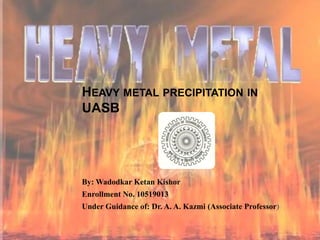
Heavy Metal Precipitation In Uasb
- 1. Heavy metal precipitation in UASB By: Wadodkar Ketan Kishor Enrollment No. 10519013 Under Guidance of: Dr. A. A. Kazmi (Associate Professor)
- 2. Introduction
- 3. Need of study Objective of study
- 7. Log concentration diagram of H2S, Sawyer et al. (2003)
- 8. Solubility of Metal-sulphide as a function of pH (Source: http://cpe.njit.edu)
- 9. Figure: precipitation of heavy metal w.r.t. pH (METCALF ET AL. 2003)
- 10. Competition between SRB’s and MPB’s investigated by Isa et al. (1986) and following reaction occurs: COD/SO42- ratio = 0.67 (stochiometrically) for equal SRB and MPB activity. At lower COD/SO42- ratio, SRB predominates over MPB. Hence ratio of 1.7-2.7 was suggested by Choi and Rim (1991) so that methane production and sulphate reduction are not affected.
- 12. Case study
- 13. Case study 1: Lead removal through biological sulphate reduction process, Hoa et al. (2007)
- 14. Figure 3.2, 3.3, 3.4, 3.5, 3.6, (Hoa et al. 2007)
- 15. Case Study 2: Heavy metal removal from synthetic wastewaters in an anaerobic bioreactor using stillage from ethanol distilleries as a carbon source, Goncalves et al. (2007) Table 1 description of 4 runs, (Goncalves et al. 2007)
- 16. Organic removal-Sulphate reduction, (Goncalves et al. 2007)
- 19. Figure 3.8 metal removal, (Goncalves et al. 2007)
- 20. Case Study 3: Effect of Sulphur Source on the Performance and Metal Retention of Methanol-Fed UASB Reactors, Zandvoort et al. (2005) The effect of sulphur source on the performance and metal retention of methanol-fed UASB was investigated. Different sources of sulphur were supplied, eg. Sulphate or L-cysteine. Methanosarcinabarkeri perform assimilatory action. L-cysteine is a ligand that will complex with metals present in the wastewater. Dissimilatory by SRB Sulphate can be reduced by Assimilatory by methanogenic bacteria
- 22. Figure 3.9 (Zandvoort et al.2005) Figure 3.9: Evolution of the reactor performance of R1 and R2 with time. (A) R1: influent methanol (♦), effluent methanol (■), and effluent VFA (▲) concentration. (B) R2: influent methanol (♦), effluent methanol (■), and effluent VFA (▲) concentration. (C) Methane production of R1 (―) and R2 (―) start of period II, L-cysteine addition to R1 (1st dotted line) and start of period III no sulphur source and trace element solution in both reactors (2nd dotted line). (D) Maximum specific methanogenic activity (pH 7; 30 °C) of UASB sludge with methanol as the substrate as a function of time. Activity of R1 (♦) and R2 (■) after 30 days and after 77 days of operation.
- 23. Conclusion and Gaps identified:
- 24. Reference: Fang, H. H. P. (1997). "Inhibition of bioactivity of UASB biogranules by electroplating metals " Pure & Appl. Chem. 69(11), 2425-2429. Goncalves, M. M. M., da Costa, A. C. A., Leite, S.G.F., Sant’AnnaJr, G.L., (2007). "Heavy metal removal from synthetic wastewaters in an anaerobic bioreactor using stillage from ethanol distilleries as a carbon source." Chemosphere 69, 1815-1820. Hoa, T. T. H., Liamleam, W., Annachhatre, A. P., (2007). "Lead removal through biological sulfate reduction process." Bioresource Technology98, 2538-2548. Isa, Z., Grusenmeyer, S., Verstraete, W., (1986). "Sulfate Reduction Relative to Methane Production in High-Rate Anaerobic Digestion: Microbiological Aspects." Applied And Environmental Microbiology51(3), 580-587. Jong, T., Parry, D. L., (2003). "Removal of sulfate and heavy metals by sulfate reducing bacteria in short-term bench scale upflow anaerobic packed bed reactor runs." water research37, 3379-3389. Metcalf & Eddy inc., (2003). In: “ Wastewater engineering treatment and reuse”, Tata McGraw Hill Publishing Company Limited, New Delhi, p.515 Sawyer, C. N., McCarty, P. L., Parkin, G. F., (2003). chemistry for environmental engineering and science. New Delhi, Tata-Mcgraw Hill. Velasco, A., Ramirez, M., Volke-Sepulveda, T., Gonzalez-Sanchez, A., Revah, S. (2008). "Evaluation of feed COD/sulfate ratio as a control criterion for the biological hydrogen sulfide production and lead precipitation." Journal of Hazardous Materials 151(2008), 407-413. Yoshizaki, S., Tomida, T., (2000). "Principle and Process of Heavy Metal Removal from Sewage Sludge." Environ. Sci. Technol 34(8), 1572-1575. Zandvoort, M.H., van Hullebusch, E. D., Gieteling, J., Lettinga, G., and Lens, P. N. L., (2005). "Effect of Sulfur Source on the Performance and Metal Retention of Methanol-Fed UASB Reactors." Biotechnol. Prog 21(3), 839-850.
- 25. THE END Be clever with Heavy Metals Thank you
Editor's Notes
- Organic substrate act as electron donor and sulphate act as electron acceptor and hence gets reduced to sulphideResulting in formation of sulphidesAlso hydroxide precipitation wl increase the pH of sewage which wl affect the functioning of UASB
- Lower the organic content lower the efficiency of sulphate reductionMeans if high sulphate content is there and high COD content is there COD/SO42- ratio could be less.
- AIS and AAS are categorised on the basis of metals absorbed or adsorbed on the biomass.Mg and Al are not removedHeavy metals from the sludge can be removed by HCl , 8% phosphoric acid with hydrogen peroxide
- Gin et al. (2002) developed an equilibrium model for describing the relationships between important parameters for lead sorption by algae, which was derived through a thermodynamics approach. The results of the application of a sequential extraction partitioning procedure indicated that an important part of the lead content is carried by the residual phase and also a significant percentage of lead in the organic and reducible fraction represents the bio-availability of lead.
- Activity of SRB and MPB are optimum at COD/S ratio 2:1Lead removal efficiency observed was around 80-85%Gas production was optimum at ratio of 2:1Also the optimum pH observed was around 7.5-8.5
- Methanol was getting converted into methane and in VFA in period I of R1
